Introduction
If you’ve ever dreamt of road-tripping through jaw-dropping scenery that feels like a blend between Middle Earth and another planet entirely, then Iceland’s south coast is calling your name, Mr Frodo. This stretch of the country is like an Iceland greatest hits album, with all the iconic waterfalls, the famous black sand beach, colossal glaciers, and glacier lagoon packed into one absurdly scenic drive.
It’s the perfect playground for campervan travellers who want to wake up to a glacier view, chase rainbows over waterfalls, and picnic beside Puffins (if you’re coming in summer). And the best part? You can do it all on your own schedule, pulling over for scenic walks, hot springs, or simply because the sky just did something magical (ahem, we get some crazy Northern Lights in winter, just saying!)
In this guide, we’ll walk you through the ultimate self-drive south coast itinerary, complete with must-see stops, extra hidden gems only the locals know about, and everything you need to know to make the most of your campervan adventure.
Why Explore Iceland’s South Coast?
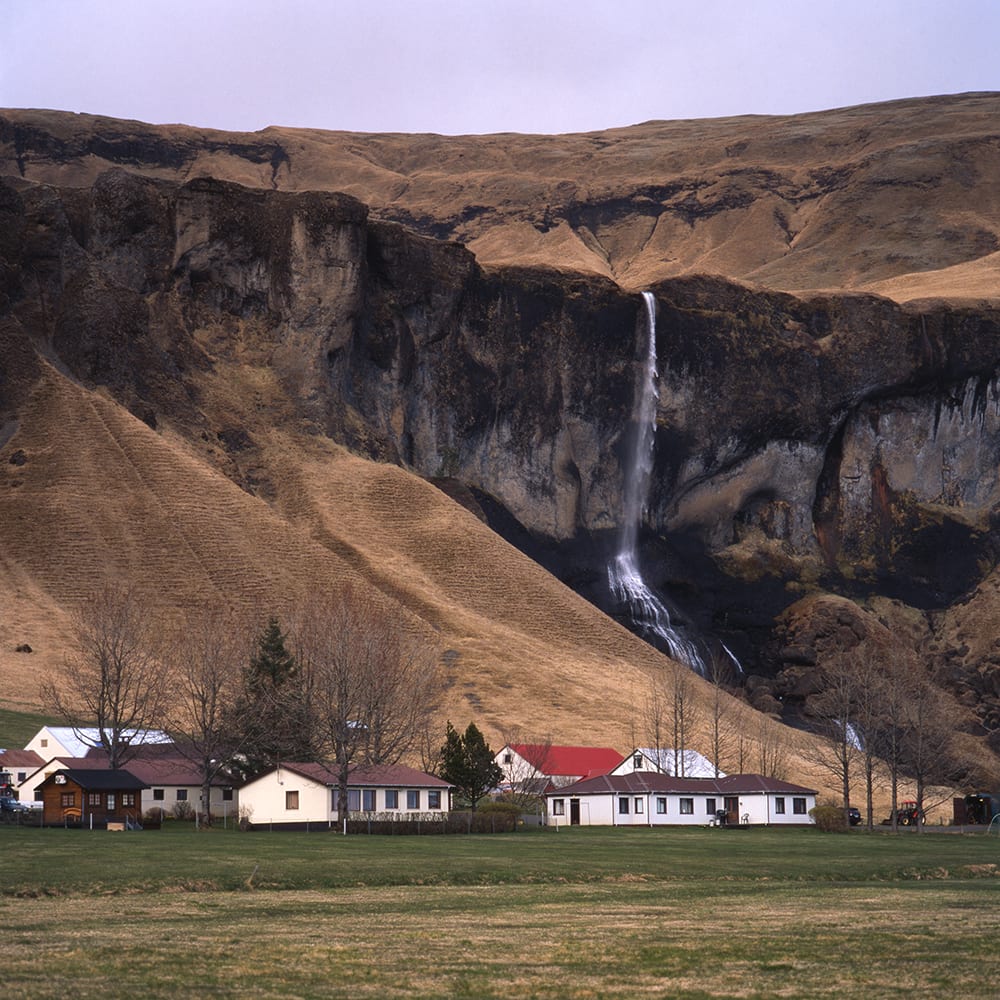
Because it’s ridiculous. In the best way.
Iceland’s south coast is like someone gave Mother Nature a blank canvas and a flair for the dramatic. In just a few hours of driving, you’ll pass waterfalls you can walk behind (I’m looking at you Seljalandsfoss and Kvernufoss), glaciers you can hike on, the famous Reynisfjara black sand beach that is incredibly unique, and ancient volcanoes that occasionally make the news (not to mention the vast lava fields you’ll drive through for hours!)
Whether you’re chasing the Northern Lights in winter or soaking up the midnight sun in summer, the South Coast delivers that big “wow” energy without needing to venture into the more remote corners of the island, which makes it easily one of our most popular travellers routes.
Plus, the roads are easy to navigate, there are campsites in all the right places, and you’re never too far from your next coffee, fuel stop or mind-blowing view.
How Long Do You Need? (3–5 Days Suggested)
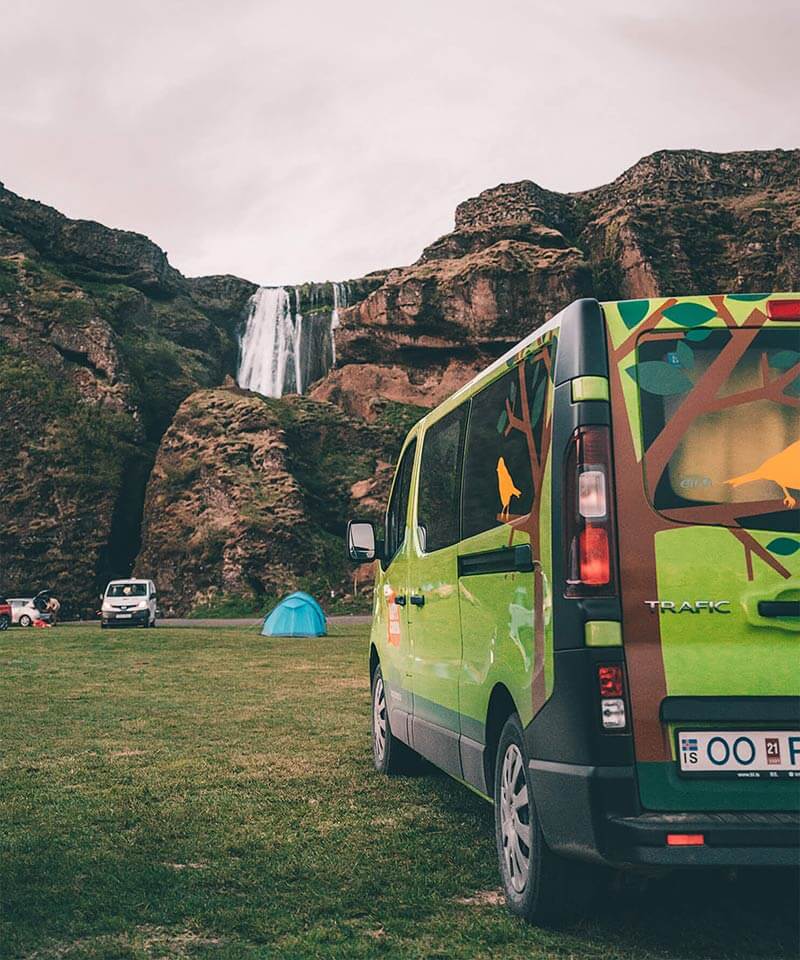
Three days will give you a solid overview of the south coast’s showstoppers. You’ll get to tick off the heavy hitters like Skógafoss, Jökulsárlón glacier lagoon and Reynisfjara black sand beach without having to sprint between them (though your camera’s shutter might feel otherwise). Expect a packed but doable adventure that hits all the big-name stops with time for a scenic coffee or two.
Four or five days? This is a pretty comfortable approach to this region and gives you the chance to take it at a steady pace. You’ll have space to linger at your favourite spots, add in a few under-the-radar gems like Múlagljúfur Canyon or Dverghamrar, and maybe even throw in a glacier hike or a Katla ice cave tour.
With a bit of extra time, the trip becomes more about experiencing than just ticking boxes. And you’ll still have time to pull over when a reindeer decides to cross the road at the most inconvenient moment (I’ll be honest, it’s usually sheep, but I’ve seen Reindeer going rogue in their small family herds near Jökulsárlón glacier lagoon in winter).
Shorter than three days? It’s possible, but you’re cramming a lot in to a small time period, so it depends on how you like to travel. You’ll be zipping from stop to stop like you’re on a scenic scavenger hunt. You’ll still see incredible things, but be ready for a blur of waterfalls, snack-fuelled drives (you’ll need a Nocco or two – this is Nordic Red Bull), and have plenty of time to fight about which spot you want to get to first.
Campervan Self-Drive vs Guided Tours: What’s Best for You?
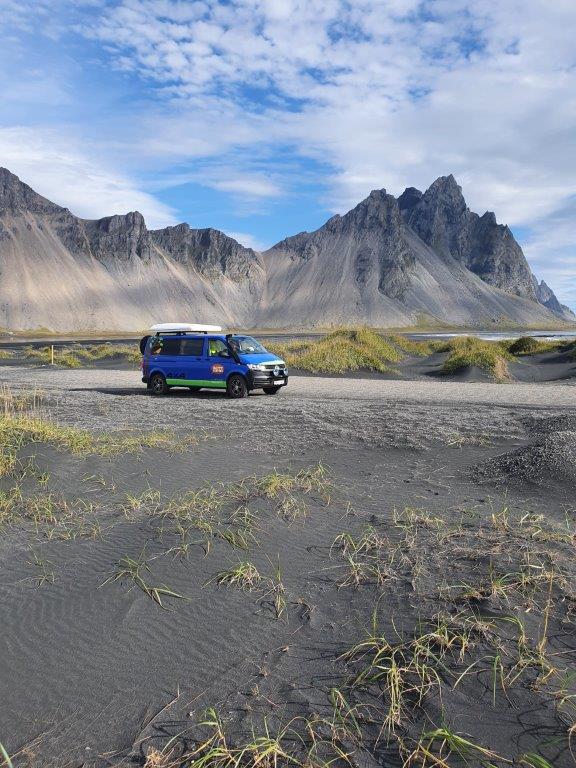
This isn’t just us being biased, but campervans really do win this round.
Guided tours are fine. They get you to the sights, they come with a guide, and they do all the planning for you. But here’s what they don’t offer: freedom (and, no, I’m not trying to sound like a politician here). Want to chase the light for a better photo? Stop to cook noodles in front of an awesome glacier tongue? Pull over because a random hot spring looks inviting? You can’t do that on a coach I’m afraid.
In a campervan, the road is yours. You sleep where the views are best (legally, at campsites), eat when you’re hungry, and can change your plan on a whim. And let’s be honest, watching the Northern Lights from your camper window with a hot chocolate in hand beats hotel TV every time, no matter if you’re like my parents and can’t even fathom a night away without BBC News on in the background!
If you’re still on the fence, https://happycampers.is/campers/ to see how this could fit your travel plans, and maybe even tick off a fantastic bucket list item at the same time.
Day-by-Day South Coast Itinerary Overview
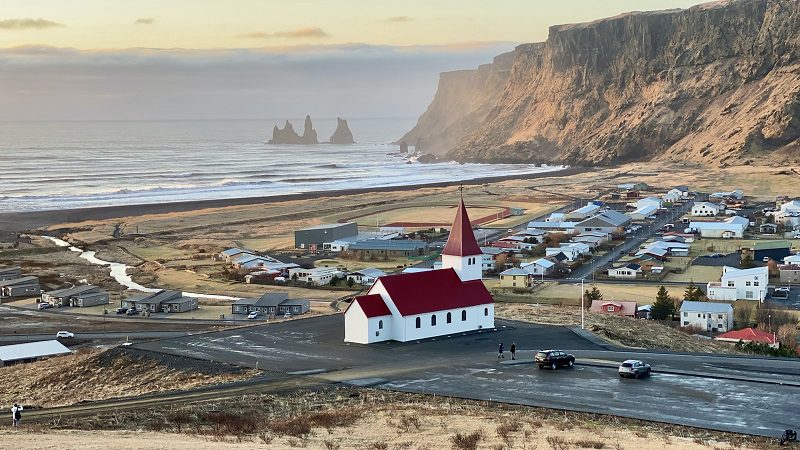
Day 1: Reykjavík to Vík
Leave Reykjavík and head east along the Ring Road. This day is packed with waterfall wonders. Stop off at Seljalandsfoss first (it’s huge and you can walk behind it), then continue to Skógafoss, where you might spot a rainbow or two.
After that, you’ve got two equally epic choices. Either make your way to Sólheimajökull glacier for an icy detour that’ll give you a National Geographic type of viewing (even if you’re not intending to join a glacier hiking tour), or swing past the quirky Yoda Cave. Officially known as Hjörleifshöfði Cave, it’s tucked into a rocky outcrop just off the Ring Road and bears an uncanny resemblance to a certain wise Jedi master when the entrance is viewed from the inside. Star Wars fan or not, it’s a fun and eerie photo op that’s usually free of crowds…and Ewoks (I’m more of a Trekkie, so finding this reference took a moment).
Finish your day in Vík, where you can visit Reynisfjara Beach and maybe grab a bite at Sudur-Vik. Park up at the Vík Campsite and call it a day with the famous troll Reynisdrangar sea stacks on the horizon and the sound of crashing waves as your lullaby.
Day 2: Vík to Skaftafell
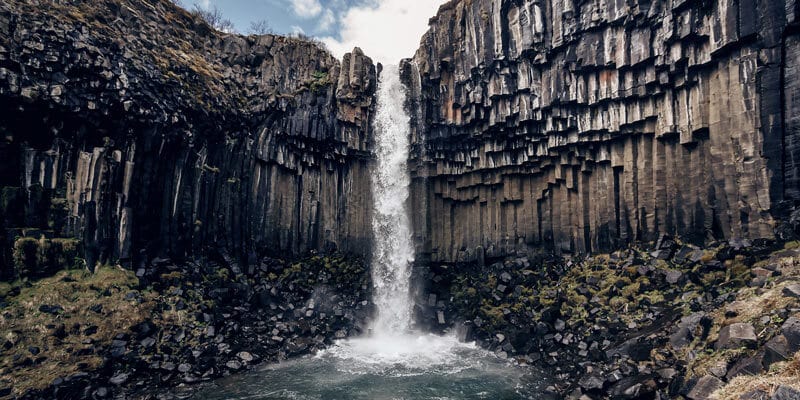
Head further east, where the landscape begins to feel even more like a fantasy set. If you’re not in the driving seat, you can tell el capitan all about how you are driving through the old Laki Eruption lava fields (1783 – 1784) who’s ash cloud caused such impact in Europe, it is believed to have had an impact on the French Revolution.
Stop off at Fjaðrárgljúfur Canyon, which is a winding green marvel that’s somehow both dramatic and peaceful, and also a film location from Game of Thrones (no dragons included sadly). It’s a short detour and absolutely worth it, even if the pronunciation feels impossible.
From here, you’ll drive into the heart of glacier country with a visit to Skaftafell in Vatnajökull National Park. This nature reserve is a hiker’s paradise, with trails leading to Svartifoss waterfall where jagged black basalt columns create a scene that looks like someone melted down a cathedral and rebuilt it in Lego (it also famously inspired the architecture of Hallgrímskirkja church in downtown Reykjavík).
Settle in for the night at Skaftafell campgrounds, surrounded by glacier tongues and towering peaks. Tomorrow, the ice adventures begin.
Day 3: Skaftafell to Jökulsárlón Glacier Lagoon
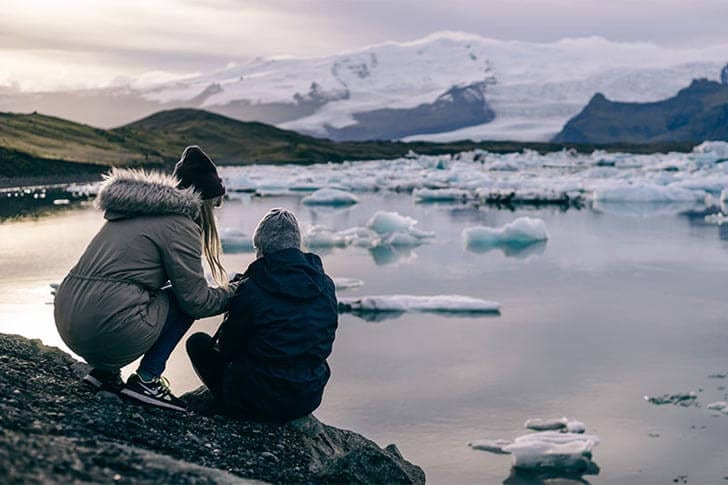
You’re in glacier country now, and today is where it all peaks (literally and figuratively). First up: the legendary Jökulsárlón Glacier Lagoon where you’ll watch massive chunks of ice, fresh from Vatnajökull glacier, drift silently across the lagoon, creating a surreal, slow-motion ballet of ice and water.
The lagoon is fed by the Breiðamerkurjökull glacier tongue, and those drifting bergs? They’re hundreds (sometimes thousands) of years old, originating from the last ice age. Keep your eyes peeled if you decide to join a boat tour (I suggest a Zodiac tour) there for seals resting on the ice – a walrus named Wally (he didn’t tell us his name, but we lovingly called him that) has also been seen across the road on the Diamond Beach in the past.
Just across the road lies Diamond Beach, where glittering shards of ice wash up on jet-black volcanic sand. It’s the kind of place where your camera battery will absolutely give up before your interest does.
End the day by returning to Skaftafell Campgrounds if you’re looping back, or continue east and camp near Höfn if you’re planning to head into the East Fjords. I’d also personally recommend coming back to the lagoon in the late evening hours to see the Aurora dance above Vatnajökull glacier in winter, or the stunning golden colours in summer that mirror perfectly on the lagoon waters.
Day 4+: Optional Extensions (Fjaðrárgljúfur Canyon, Westman Islands, and More)
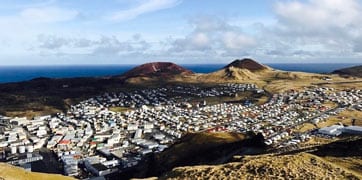
Got extra time? Lucky you.
Double back to explore what you might’ve zoomed past earlier. If ferry schedules line up, the quirky Westman Islands are worth the detour, particularly if you are travelling in summer. It’s a great location to see puffins, learn about more eruption history, and a whole lot of charm on a volcanic archipelago.
Prefer staying on the mainland? Swing by the hauntingly symmetrical Dverghamrar cliffs I mentioned earlier or stop for a scenic pause in the storybook village of Kirkjubæjarklaustur.
If you’re in the mood for something truly cinematic (and you didn’t stop there already), head towards the hidden Múlagljúfur Canyon. This off-the-radar wonder offers jaw-dropping views, misty cliffs and the kind of trail that’ll make you forget all other hikes ever existed. It’s the kind of place where you half expect a dragon to fly out of the clouds, but perhaps more realistically, an overenthusiastic drone photographer.
Top Stops on the Iceland South Coast Up to Vík
1. Seljalandsfoss Waterfall
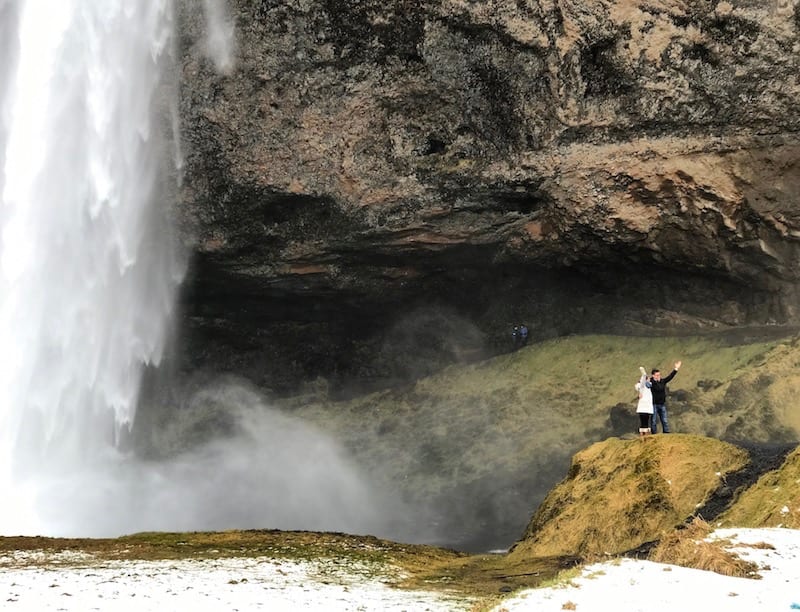
Walk behind it. Get soaked. Laugh about it. Repeat. Just make sure you bring waterproofs and expect to look like a drowned rat in all your photos.
But Seljalandsfoss isn’t just here for your waterproof test. It’s steeped in Icelandic folklore. Local legends say the cave behind the falls once offered shelter to outlaws and wandering spirits. And if you visit just before midnight on Midsummer’s Eve, some say you might spot elves dancing nearby, or at least feel like you’ve stumbled into a fairytale (full disclosure, I’ve never seen an elf).
This iconic waterfall tumbles 60 metres off a former sea cliff, part of what was once Iceland’s ancient coastline. Now inland thanks to thousands of years of geological shift, it’s become one of the few waterfalls in the world where you can stroll all the way behind the cascade. But be careful, those wet stones can be slippery, and unless you’re aiming for a slow-motion comedy moment, take it slow around the loop.
2. Skógafoss Waterfall
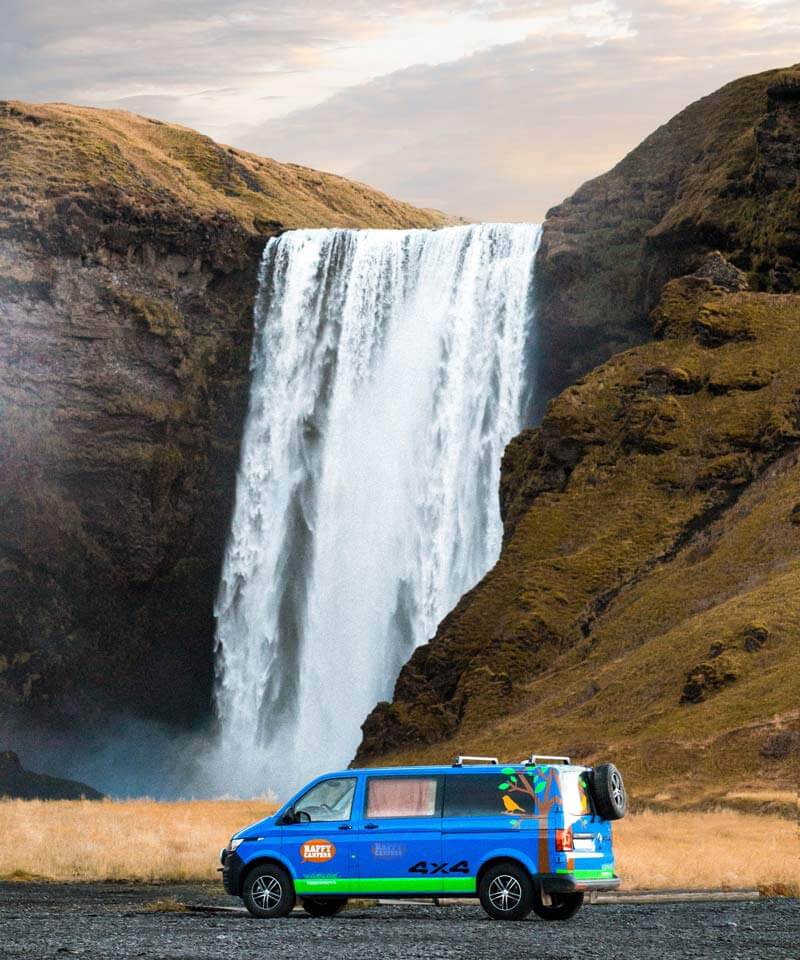
Tall, thunderous, and usually wrapped in rainbows like nature’s photoshopped site. Skógafoss plunges 60 metres from the former sea cliffs and is one of Iceland’s most iconic waterfalls, and not just for its good looks. Legend has it that a Viking settler named Þrasi Þórólfsson hid a chest of treasure behind the falls, and while many have tried to find it, all that’s ever been retrieved is a ring from the chest’s handle, now kept in a local museum.
Climb the metal staircase to the top for sweeping views of the coastline and the Mýrdalsjökull glacier in the distance, looking East, and the famous Eyjafjalljökull glacier and volcano to the West.
Just be prepared for a bit of a leg workout (and a lot of puffing if you’re doing it in full waterproof gear). Stay at the base if you’re keen on capturing those cinematic splash-zone steamed up selfies or fancy feeling the mist kiss your face.
3. Mýrdalsjökull & Sólheimajökull Glacier
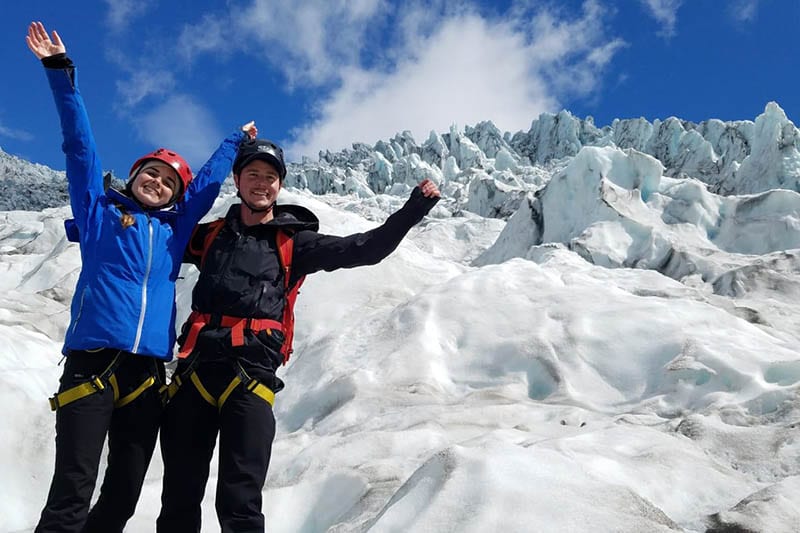
Book a glacier hike or ice cave tour and walk on ancient ice that has witnessed centuries of Icelandic folklore unfold. These massive ice formations are not only streaked with volcanic ash and glowing with blue crevasses, but they’re also part of local legends. Some say the ice carries the memories of old Icelandic sagas, whispering ancient tales through the wind that whips across the glacier (a bit whimsical, but I can see it).
Vatnajökull glacier, the largest of them all (and Europe’s largest glacier), has even been nicknamed ‘The Sleeping Giant’ by locals, hinting at both its vast power and the volcanic beast that lies beneath. Whether you’re trekking across Sólheimajökull or peering into a crystal-blue ice cave, it’s an adventure carved straight from Iceland’s mythical past. You will 100% need your camera.
4. Reynisfjara Black Sand Beach
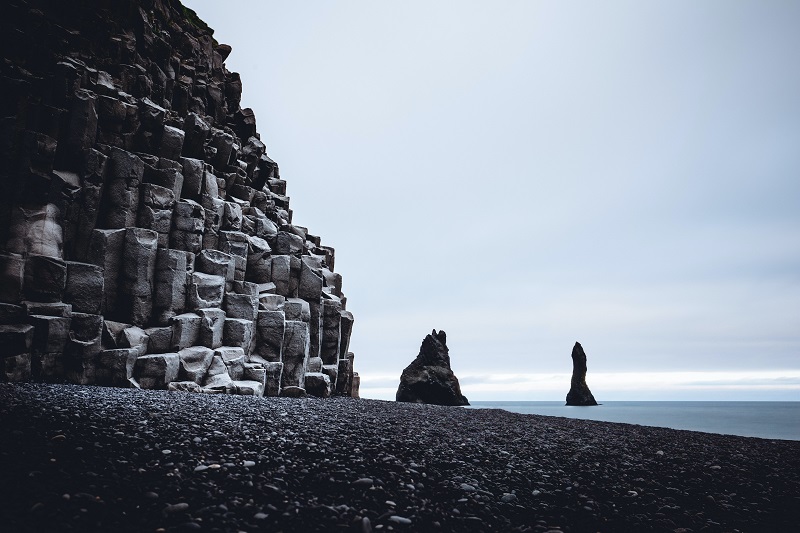
It’s dramatic, moody, and utterly unreal, like the set of a Viking noir film (if such a genre existed). Reynisfjara Beach, with its jet-black sands and towering basalt columns, is not only famous for its otherworldly appearance but also steeped in Icelandic folklore (are you see a trend here?)
Local legend says that the Reynisdrangar sea stacks just offshore are actually trolls who were turned to stone by the morning sun while trying to drag a ship to shore. As poetic as that sounds, it’s also a stark reminder that nature rules the show here.
And speaking of rules, don’t get too close to the shoreline, those infamous sneaker waves have caught out even the most careful visitors. Trust us, the beach looks just as spectacular from a safe distance – it also comes with the confidence that you’ll see the next day!
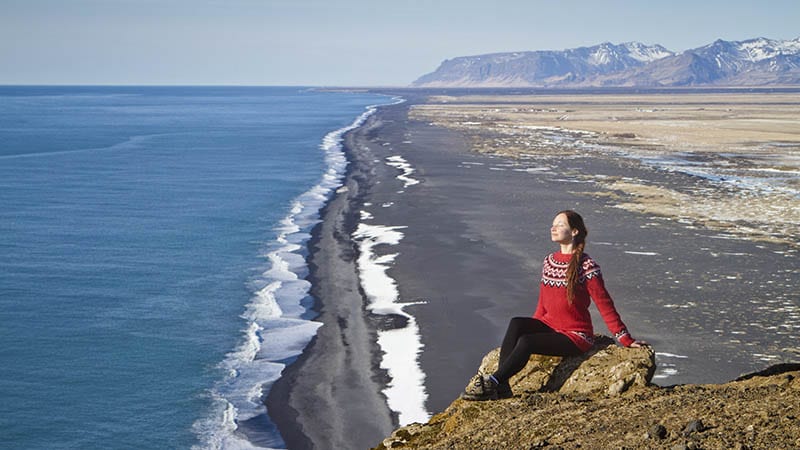
Dyrhólaey isn’t just a viewpoint, it’s a windswept cliff steeped in geological drama. This promontory juts boldly into the North Atlantic, offering panoramic views across black sand beaches, wave-battered arches, and endless ocean. Its name translates to “door hill island,” thanks to the massive arch-shaped rock formation that ships have reportedly sailed through (though we don’t recommend trying it with your camper).
Atop the cliffs sits the iconic Dyrhólaey lighthouse, a squat little guardian first lit in 1927, keeping watch over this wild stretch of coast. In summer, the area becomes puffin central, with the comical seabirds clowns nesting in the grass-tufted cliffs and making dramatic dives into the sea like they’re late for fish dinner.
Local legends (of yes, that’s right, there’s more) whisper of sea trolls frozen in the ocean beyond, while the jagged rock formations offshore continue to stir the imagination. Whether you’re there for the birdlife, the views, or the eerie echo of Icelandic myth, Dyrhólaey is where natural beauty meets ancient storytelling in one unforgettable stop (not to mention it’s a very cool drive to get to).
From Vík to Vatnajökull: Glacier Country
This stretch of Iceland’s South Coast feels like someone dialled up the dramatic scenery to eleven (yes, I’m an obvious millennial writer!) The journey from Vík to Vatnajökull takes you through some of the most incredible, ice-covered, folklore-laced landscapes in the country.
We’re talking glacial tongues that spill down from ancient peaks like frozen rivers, black sand deserts that stretch endlessly under the watchful eyes of looming volcanoes, and nature reserves where every hiking trail leads to something more stunning than the last. And yes, sometimes even the local legends come to life, like the whispers of trolls in the lava fields or spirits said to linger near forgotten waterfalls (I tend to think this can be heard best when alone, hearing the winds crash against the wild landscapes).
This part of the drive is where Iceland flexes hard. You’ll be weaving between centuries-old glaciers, climbing to panoramic viewpoints, and probably pulling over every ten minutes for another picture stop. It’s glacier country, storybook country, and adventure country all in one.
6. Skaftafell Nature Reserve
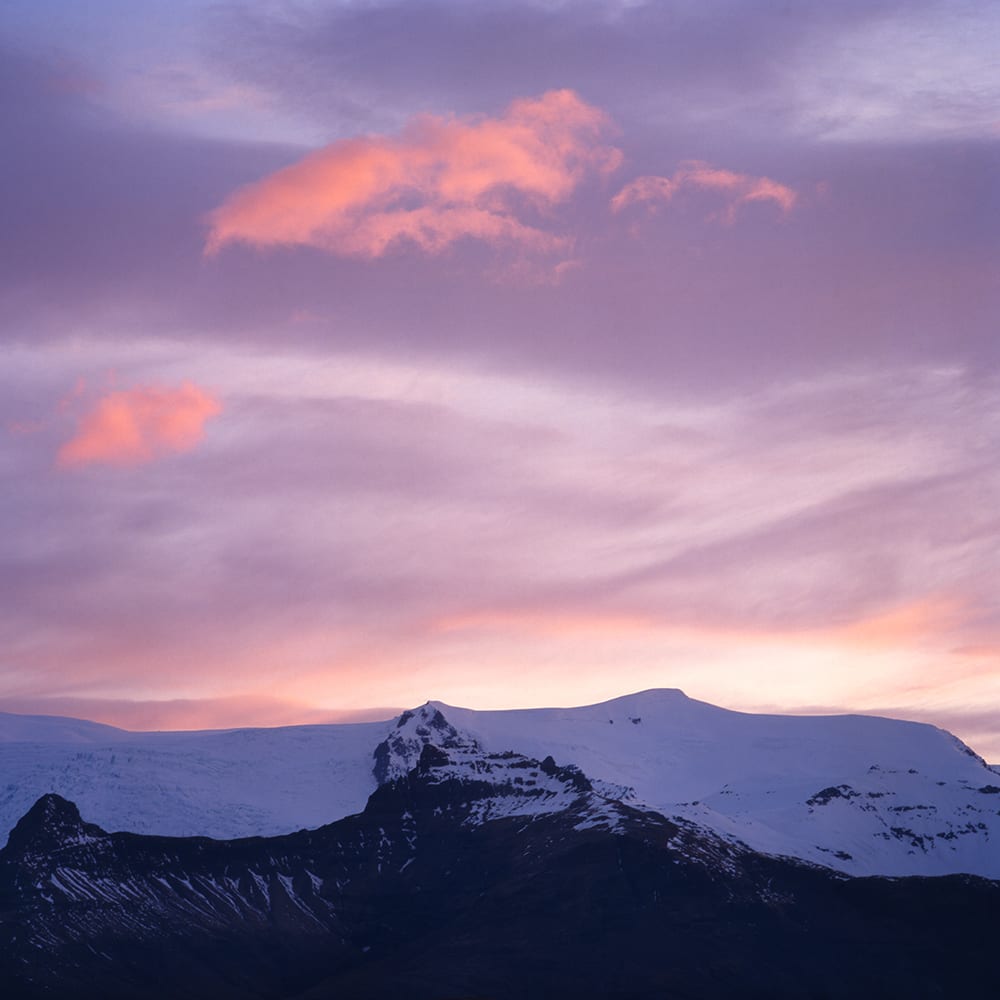 Pink skies at night in Skaftafell
Pink skies at night in Skaftafell
This place is made for hiking, and not just the casual Sunday kind. Skaftafell Nature Reserve is where glacier tongues meet mossy trails, and every path winds upwards towards something cool (a glacial tongue, a waterfall, or both).
Take the trail to Svartifoss and you’ll find a stunning waterfall framed by pitch-black basalt columns, earning it the nickname “Black Falls.” According to local stories, the distinctive columns were once thought to be a gateway to the hidden world of the huldufólk, the hidden people of Icelandic folklore.
For those chasing a chillier thrill, glacier walks on Falljökull or Skaftafellsjökull offer the chance to crunch across centuries-old ice. Guides here will sometimes share old tales of trolls frozen in the ice, or of ghosts lost in snowstorms (very rarely anything positive there!)
7. Vatnajökull National Park

Welcome to Vatnajökull, the icy overlord of Europe. This glacier is so massive it covers almost a tenth of Iceland’s landmass, and no, that’s not a typo. It’s a frozen behemoth of ancient ice, and it plays a starring role in many Icelandic sagas and modern films alike.
Folktales tell of trolls and hidden people who once roamed its edges, vanishing into crevasses and emerging only under moonlight. Some stories even claim that the glacier hides gateways to other realms (not the Metaverse), though you’re more likely to find a glacier hiking tour than a secret portal these days. Still, the mystique is real.
Vatnajökull isn’t just vast; it’s also home to several sub-glaciers and sits atop some of the most active volcanoes in the country, including Grímsvötn. Which means, in true Icelandic fashion, it’s both a spectacular sight and a ticking geological time bomb. Don’t worry though, there are monitoring systems in place measuring seismic activity in real-time.
8. Jökulsárlón Glacier Lagoon
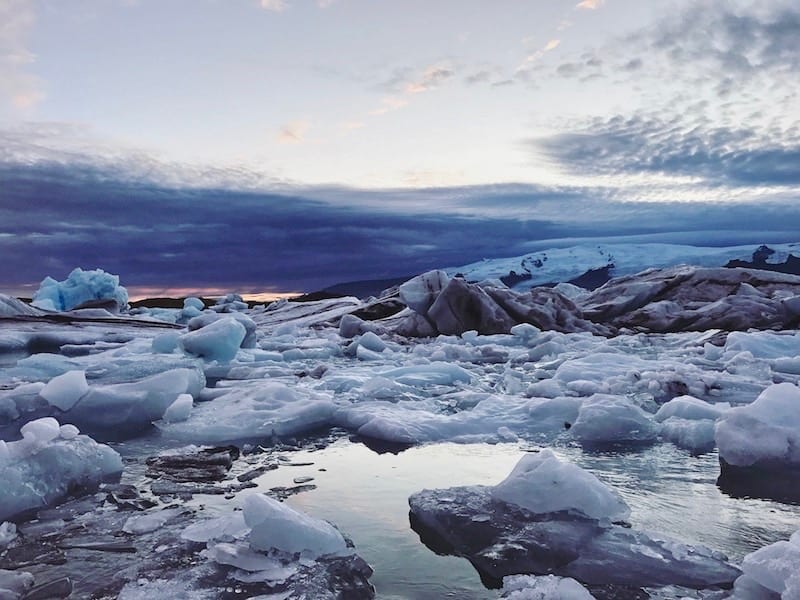
Icebergs float by like ancient sculptures on parade. Seals lounge atop the ice as if auditioning for a nature documentary. And tourists? They stand wide-eyed and amazed, cameras clicking, trying to make sense of the surreal sight before them.
This isn’t just any lagoon, Jökulsárlón is where thousand-year-old ice calves from the mighty Breiðamerkurjökull glacier and drift lazily towards the sea. Folklore whispers that these icebergs are guardians of the glacier, drifting out to sea with messages from the mountains (I more tend to think it’s global warming in action, given the rapidity of the melt in recent decades).
During calmer moments, the lagoon mirrors the sky in a way that feels more dream than real, especially later in the evening. And if you’re lucky, you might spot a seal popping its head up between the icebergs, like it’s checking in on the day’s visitors. It’s no wonder this place has starred in films like Batman Begins and Die Another Day.
9. Diamond Beach (Fellsfjara)
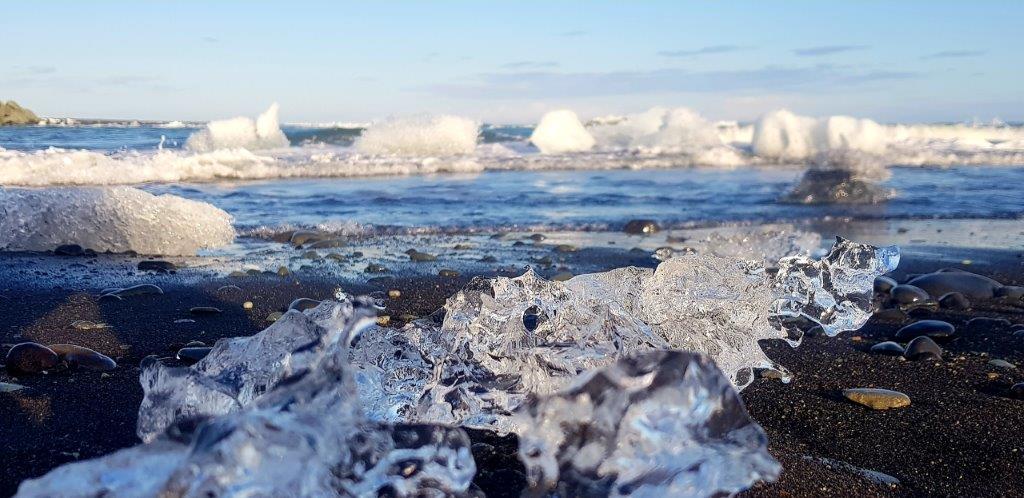
Black sand, white ice. Nature’s version of cookies and cream, and one of the most surreal natural contrasts you’ll find anywhere in the world. This stretch of shoreline, known as the Diamond Beach, lies just across the road from Jökulsárlón Glacier Lagoon. Here, chunks of ancient glacier float out to sea, only to be sculpted by the waves and washed back up onto the volcanic black sand. The result? A beach scattered with sparkling white and blue and crystal-clear icebergs that glitter like actual diamonds. Some are small, and some are huge and will tempt you to climb on them, but please be careful – in the past, people have been swept out to sea (a bit embarrassing to get that distress call!)
There’s something almost mythic about the scene, and fittingly, local folklore says the icebergs are the spirits of lost giants sent down from the glacier to rest by the sea. Whether you believe the legends or not, there’s no denying the place feels enchanted. It’s one of those rare spots that manages to feel peaceful and dramatic all at once. Just watch your step, as those ice shards might look pretty, but they can be as sharp as your cousin’s elbows at the family dinner table (many of my family are from Liverpool, so I’m maybe more aware of this than others!)
Bonus Stops & Hidden Gems Along Iceland’s South Coast
The South Coast is packed with secret spots and lesser-known wonders that are just waiting to steal the show. These are the kind of places that rarely make the travel guides but leave a permanent mark on your memory. Some are quiet detours into Iceland’s ancient history, others are just downright weird in the best possible way. Either way, if you’ve got a bit of time and a campervan full of curiosity, this is your chance to add some unexpected magic to your road trip along the incredible south coast (some of these I touched on above).
10. Dverghamrar Cliffs & Foss á Síðu
 Photo Credit: JD554 via Wikimedia C.C.
Photo Credit: JD554 via Wikimedia C.C.
Small in size but massive in myth, Dverghamrar is one of those spots where geology and folklore collide in the best way possible. These basalt cliffs look like someone carefully stacked nature’s version of organ pipes into neat columns. And according to local legend, this wasn’t just a random rock formation, it was home to dwarves (I bet 90% of you just read this in Gimli’s accent). Yes, actual dwarves. Or at least, that’s what Icelandic folklore says. These stone-dwelling creatures were said to live in harmony with nature, mostly keeping to themselves unless disturbed.
Some locals still speak of hearing strange echoes or seeing flickers of movement out of the corner of their eye when passing through. Whether you believe the stories or not, the formations themselves are fascinating, formed by ancient lava flows cooling slowly into hexagonal columns.
Dverghamrar sits just off the Ring Road and is a quick stop that packs in plenty of atmosphere. Plus, it’s right next to Foss á Síðu, a picturesque ribbon-like waterfall that often gets overlooked. Together, they make for a stop full of quiet magic, and possibly a hidden dwarf or two (assuming you’re cool with hitchhikers!)
11. The Westman Islands (Vestmannaeyjar)
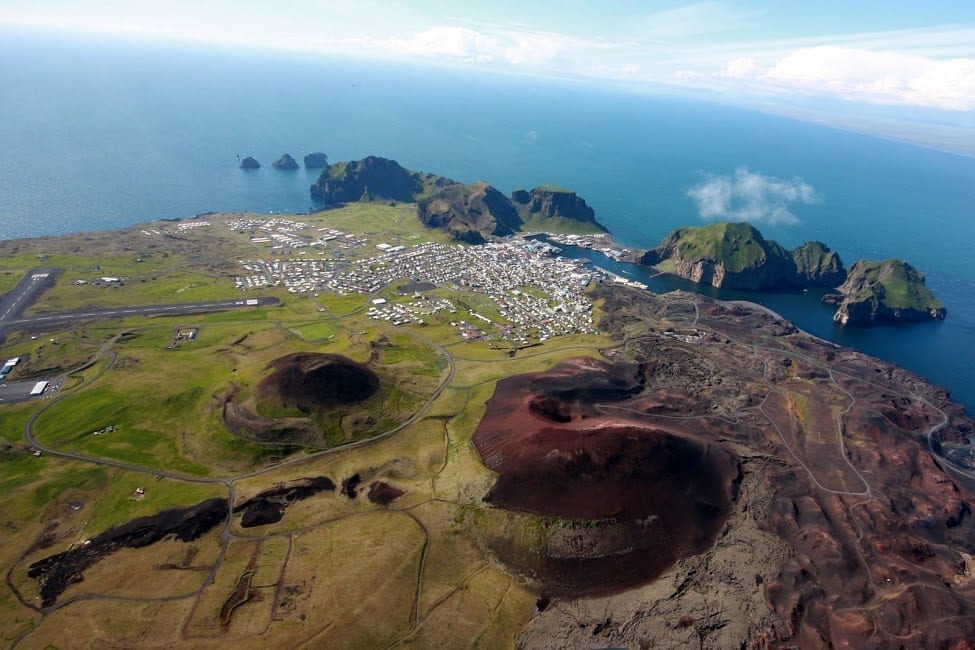
Take the ferry and step into one of Iceland’s most geologically fascinating and historically rich destinations. The Westman Islands (or Vestmannaeyjar if you want to impress the locals) were dramatically reshaped by a volcanic eruption in 1973 that added a whole new landmass to the town of Heimaey and forced the evacuation of its population.
Today, you can visit Eldfell volcano, walk on lava fields that are younger than many of us, and even spot houses partly buried in ash preserved at the Eldheimar Museum. Due to the heat that is emitted from Eldfell volcano, you can even cook bread here by burying it in a tin overnight, having dug a small hole in the side of the volcano (Gordon Ramsay’s got stolen!)
This cluster of islands is also one of the best places in Iceland to see puffins up close, especially in summer when the cliffs become squawking, flapping real estate for these oddly adorable birds.
Football fans might appreciate that the island’s main pitch is built right on the edge of a crater, because of course it is. From lava walks and cliff hikes to boat tours and folk legends of giants guarding the shores, the Westman Islands are a detour that punches way above their weight in wow factor.
If Puffins are your poison, visit in the summer months and head straight for Stórhöfði – there’s a great indoor viewing point here to escape the cold and wind also whilst taking your pictures.
Planning Tips for a South Coast Road Trip

When to Visit
Summer in Iceland means near-constant daylight, with the midnight sun stretching your days so long you might forget what bedtime feels like. This season unveils lush green landscapes, open Highland roads, and an atmosphere that feels made for campervan adventuring. You’ll find every waterfall flowing strong, every trail hikeable, and plenty of fellow travellers swapping stories at campsites.
Winter, on the other hand, flips the script in the most enchanting way. Frozen waterfalls stand still in icy silence, the Northern Lights dance wildly most nights with clear skies, and the crowds are a lot smaller. It’s a time of crisp air, dramatic lighting, and landscapes wrapped in snow. Yes, it’s colder, and the driving requires more care, but the trade-off is an Iceland that feels quiet, raw, and magical.
Where to Stay
Campsites are plentiful along the route, making it easy to structure your south coast journey without worry. Whether you’re parking up beneath the cliffs of Vík, enjoying glacier views in Skaftafell, or stretching your legs in scenic Höfn, you’ll find reliable and well-equipped sites to rest and recharge.
Facilities vary from the bare-bones to more comprehensive locations, but you can rest assured that one of the main benefits of visiting Iceland and our geothermal foundation is that there is no risk of not getting a hot shower.
What to Pack
Layers. Lots of them. Iceland’s weather changes more often than a playlist on shuffle, so be ready to go from sunshine to sleet in one short journey. Waterproofs are essential, and yes, even in July. Bring thermals, a swimsuit for spontaneous hot spring dips and swimming pool stops, and sturdy shoes for trails that range from squishy moss to lava rock.
Don’t forget your charger, power bank, and maybe even a solar panel if you’re feeling fancy. Your camera will never forgive you if it dies just as a reindeer casually strolls into frame, or worse, when the Northern Lights start showing off.
Need help planning your van wardrobe? Use our Iceland campervan packing guide to make sure you’ve got everything from woolly socks to waffle mix covered.
Safety Tips for Traveling Iceland’s South Coast
Iceland’s weather can be very unpredictable. You can have brilliant sunshine one moment, and howling wind and sleet the next. Also, road conditions can switch from smooth to skates-on-ice in no time, especially in winter. Always check Vedur.is for weather updates and SafeTravel.is for road safety and alerts before heading out.
And yes, that photo stop might look like the perfect place to pull over, but make sure it’s a designated safe spot – no one wants their pristine glacier shot interrupted by a tow truck or a sheep traffic jam.
Is it Better to Explore Iceland’s South Coast in Winter or Summer?
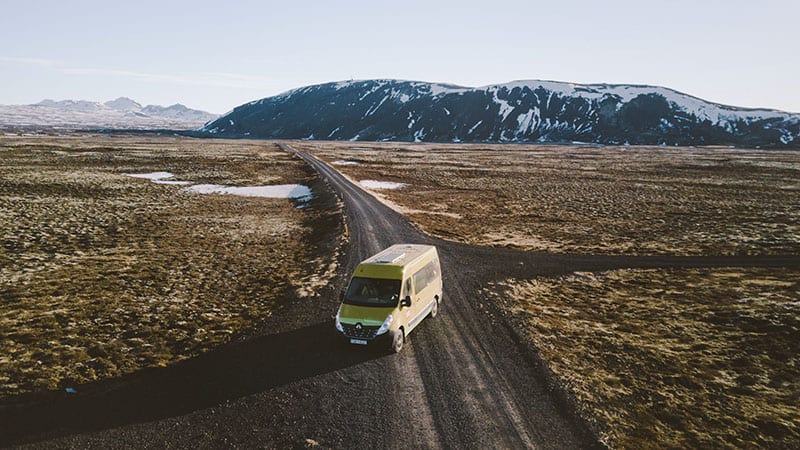
With nearly endless daylight hours, warmer temperatures, and clear access to just about every viewpoint along the south coast and beyond, summer in Iceland is prime time for glacier hikes, canyon wanders, and waterfall chases. You can drive further, hike longer, and sleep less, not because you’re tired, but because the sun just refuses to clock out, and if you’re anything like me, this means you’re up until 3am thinking it’s 7pm.
Winter, meanwhile, casts a completely different spell. Snow carpets the black sand beaches, waterfalls freeze mid-plunge like paused movie frames, and the Northern Lights crackle across the night sky like they’re putting on a private show just for you. There are fewer people, more cosy campsite evenings (at the open ones), and quieter attractions. Of course, you’ll need to be extra prepared for the weather as the roads can be slick and some routes might be closed (e.g., the Highlands are not accessible to any vehicle during the winter)þ That’s where a winter-ready campervan becomes your trusty steed through this snow-dusted igloo country.
Choosing between the two? I can’t give you a definitive answer as it all depends on personal preference. If you want unhindered exploration and more travel reliability, I’d come in summer, and if you want a more christmassy adventure and to tick the aurora off your bucket list, then definitely come in winter.
Conclusion
The south coast of Iceland isn’t just a road trip. It’s a crash course in natural wonder, a highlight reel of everything that makes Iceland, well, Iceland.
So fire up your campervan, cue the playlist, and hit the road.
We’ll see you out there, hopefully consulting thie travel guide at each stop for your next adventure.
Ready to plan your Iceland south coast adventure? Let’s get your campervan booked and your memories made.
Back